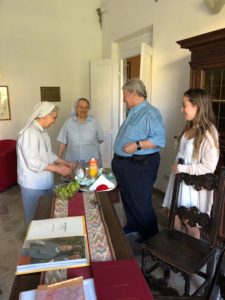Casa Santo Nome di Gesu Firenze Francescane Missionarie di Maria
By : Tali R. Faerman*
Tali Ruth Faerman is 17 years-old and is starting her senior year at the Posnack Jewish Day Schook, at Davie, Florida. She started her elementary school in Buenos Aires, Argentina, at the Martin Buber school and at age 8 she moved to Florida. Upon completion of her elementary school she was recognized with the Pinnacle Award for her capabilities, perseverance and courage to face-up changes.
Tali engages in voluntary work, not only with the IRWF. She’s also a mentor of the English program instituted at a kindergarten at La Matanza, Argentina, helping to turn it into a bilingual educational institution. She’s fluent in Spanish and English and has a good knowledge of French, Italian and Hebrew.
Mother Maddalena Lainati never loses her friendly smile while we speak in a mixture of English, Spanish and Italian, as she has a deep knowledge of all of them.
We are received at the Franciscan Mission of the Missionaries of Mary in Florence, at the corner of Piazza del Carmine. This palace was built in the 13th century where once high officials of the Medici family lived. Since 1901, it was occupied by the Mission and today twelve elderly sisters reside there.
As we enter an ample room, the area is illuminated by a plaque that indicates that we are in a House of Life. This refers to a place of survival at a time where outside these walls there reigned anti-Semitic fury and murder in general.
The convent and the passion of Mother Lainati aid us in learning about the events that took place from September 8, 1943 until the tragic night of Sunday, November 27.
On September 8, 1943, the Italians became traitors in the eyes of the Nazis when they signed the armistice with the allies. The Nazis then started a bloody persecution against the Jews and the Partisans.
That same day, the Convent began to transform itself into a House of Life. This was after following the order of the Cardinal of Florence, Elia Dalla Costa, that the Jews should be hidden there, especially in the cloister to which everyone was prohibited access to.
Sister Ester Busnelli, the superior of the Mission, organized the structure to initially hide about 50 women and their children. Meanwhile, the men were kept as refugees in nearby buildings, as they unable to remain in a home of nuns.
A system of alarms was organized for when the SS arrived or were near the area. Once hearing the alarm, the refugees would hide in an underground shelter. The system functioned smoothly until an informer told the Nazis in detail the House of Life’s mission and the way in which the persecuted were disguised.
At three o’clock in the morning of Sunday, November 27, as the sisters sounded the interior alarms that announced danger, 30 soldiers of the SS entered the convent by force. They searched room by room, even entering the cloisters of the sisters. 80 women and their children were all gathered in a room, forcibly stripped of their possessions, and interrogated to determine their Jews identity so that they could be sent to extermination camps.
One boy was thrown to the floor by his mother and hidden under the skirt of one of the sisters, thus saving his life. About 30 women, including his mother, were deported to extermination camps where none survived.
Men were not allowed in the convent, but they made an exception for the young boy, Emanuele Pacifici, who was miraculously saved. He survived, and his work and testimony made Sister Ester Busnelli recognized with the medal of justice, on August 16, 1995.
The war had more faces than simply those of the murderers and their victims. There was then also a third and kind face, the one of those who put their own lives in danger to save others. The face of those who overcame the paralyzing fear and acted with humanity in the dramatic context that dominated the world.
Today the Raoul Wallenberg Foundation recognizes those kind faces that are banners to life by designating the places where people saved one another as, Houses of Life.
In this moment, movements like BDS continue to create new forms of violence, anti-Semitism grows on university campuses, and we live in a world conditioned by terrorism. It is in this moment, where it is important to remember those humble, kind, and believing people who offered a way into life when the only option talked about was death.
In Europe there are hundreds of Houses of Life, which, like the Franciscan monastery of the Missionaries of Mary, can be visited. The “Marches of the Living ” show those who meet the lowest and most sinister face of human history and allow to reaffirm one’s conviction in the “Never Again”. The Houses of Life refute the claims of those who believe that the tragedy of the Holocaust was non-existent, by shedding light on the stories of thousands of non-Jews saving Jews who were being chased by death.
The Houses of Life help one believe that even in the worst of moments, there are men and women who decide to preserve their humanity and act to maintain a world replete with peace.




